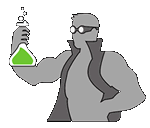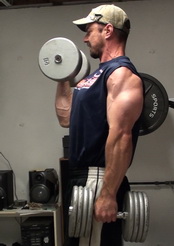If you want to build "work capacity" strength (also called fourth quarter strength) then you need to train your body to handle volume.
Top-end strength is important, don't get me wrong, but being able to perform over longer stretches of time is extremely important, especially for athletes in sports that happen over the course of hours (like football, for example, which is where the term "fourth quarter" strength comes from.
If you want to be the best player you can be, you need to be able to perform at a high level from start to finish.
This volume-based training technique allows you to use targeted nervous system activation to keep performing at a relatively high level of strength performance, even on short rest periods.
It combines two types of training methods into one powerful workout.
Strength Technique 1 - Post-Activation Potentiation
Also, called PAP for short, Post-Activation Potentiation uses heavier weights in a short range of motion to activate or "kindle" the nervous system's high-threshold motor units.
When you then go to using lighter weights for a full range of motion, those powerful motor units are already "awake" and can contract more efficiently, increasing your strength.
We're going to alternate sets of this style of training with full-range Anderson Squats.
(FYI, the way we're using it here is not the traditional way of using PAP, however it works very well for our purposes with high volume training).
Strength Technique 2 - Compound Exercise Overload Training
This is the overall framework we'll be basing the workout on.
You can get the full rundown on Compound Exercise Overload Training here.
To summarize it, normally, you would take one exercise and just use that for the entire workout. You'd select a weight you could get 6 reps with and do sets of 3 reps, taking 30 seconds rest in between sets. Then when you can no longer get 3 good reps without struggling, you reduce the weight 20 pounds and continue.
This repeats for a block of time (anywhere between 20 to 40 minutes).
How to Do Post-Activation Potentiation Compound Exercise Overload Training for Squats
It's a bit a mouthful, but it's not that complicated once you get the idea.
To this, you'll need two bars in one power rack.
Set up a weight you can do partial-range movements with (the top 5 inches or so). I've got 405 lbs on the bar. Set this up in the regular J hooks.
Now set the safety rails in the rack for Anderson Squats (bottom start squats off the rails). Use a weight you could get 6-8 reps with fairly easily...this is a volume workout, not an "intensity" workout so we're not looking for massive weights here. I used 245 lbs to start with here.
Set the bar towards the back of the rack so that you'll have room to do the partials towards the front of the rack.
In terms of rail height, I like starting out of the bottom with the thighs a little above parallel, so adjust accordingly. You can definitely start lower, if you like...it's personal preference.
This exercise is great for building power out of the bottom of the squat.
Start by performing three partial reps with the heavier load. Come down about 4-6 inches, pause briefly at the lower point, then power back up to the top.


Rack the bar, then rest 30 seconds.
Get under the bar for the Anderson Squats. Perform three reps of this.
When doing these, don't "pop" the bar off the rails...develop tension through the lower body then "squeeze" the bar off the rails, coming all the way up to the top.


Rest 30 seconds, then go again with the partials for three reps.
Continue this pattern.
When you get to the point where you can no longer get 3 solid reps on the Anderson Squats, reduce the weight by 20 pounds then continue. I only had to reduce the load once, down to 225 lbs, over the course of the full workout.
You should be able to leave the heavier load where it's at for the duration of the workout.
Using a Manta Ray for Partial Squats
I did find about halfway through, that it was better to use a Manta Ray for the partials. A Manta Ray is a plastic molded piece that attaches to the bar to better distribute the weight over the shoulders.
You can read my full review of the Manta Ray here (including where you can get one).
I find the Manta Ray to be very useful for partial training as, in addition to load distribution, it allows you to place the load more vertically on your spinal column while also preventing the bar from rolling down your back. It's not as good for full-range training due to the forward lean you have to do with a full-range squat.
It was VERY useful for this method as my hands got very sweaty and I was having a hard time keeping the bar from rolling without it.

High-Volume Squat Training
I did find at the end of this workout that I wasn't destroyed. A good volume workout actually should NOT leave you destroyed. You should know you've been worked but not so hard that you're beaten down to the ground.
This is the type of training that really builds work capacity.
If you try and do high volume AND high intensity, THAT will pretty much destroy you!
---
Are you 40...50...60 or even 70+ years old and want to build muscle and strength like you did 20 years ago?
If you feel like you're fighting a losing battle, you're ready to discover the REAL secret to REVERSING muscle loss due to aging...
*** You need to train the body systems that SUPPORT your muscle mass, not just the muscle itself. ***
These underlying support systems diminish as you age, which is why you lose muscle as you get older no matter how hard you train... but with strategic training, these systems can be regenerated.
Share This Page...
Want More Strength-Building Techniques and Programs?
You'll find them here...



